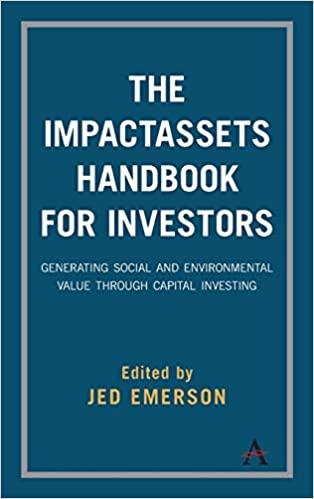Question
You have been retained by Amaia, the recent winner of the Jackpot. The jackpot total was $50,000,000. Amaia must decide whether to take the winnings
You have been retained by Amaia, the recent winner of the Jackpot. The jackpot total was $50,000,000. Amaia must decide whether to take the winnings in 30 equal payments of $1,666,667, or a lump-sum amount of $34,900,000. For simplicity well assume the annual payments, or the lump-sum payment, will be made at the end of the year. Furthermore, taxes on the winnings, as well as the earnings, can be quite complex, so for our purposes we will ignore taxes.
The payments from the state are considered to be relatively risk free, but there is still a little incremental risk over that of the federal government.
One of Amaias friends, Bran, has advised her that; First you need to calculate the implied return the state is using to discount your payments. If you then take the lump-sum and invest it in a fund with the highest expected rate of return you can find based on the past years performance, as long as that expected return is greater than the states implied return, you will definitely be better off than if you were to take the annual payments over time. And to help even further, I dont think you can possibly do better than to invest in my hedge fund, which earned a 25% return last year.
Amaia is currently 25-years old and lives a frugal lifestyle. She plans to keep the funds invested over the 30-year period no matter what option she chooses. She is also extremely risk averse, so much so that she waits 6-hours after eating before going swimming.
Amaia has retained you to (1) calculate what Bran referred to as the implied rate; (2) assess Brans recommendation regarding his hedge fund, and; (3) advise Amaia as to whether to take the up-front payment or the annual payments. If you recommend that Amaia take the lump-sum payment should she: (a) take the lump-sum payment and invest in Treasury Bonds which are currently yielding 2.00% to maturity; (b) take the lump-sum payment and invest in Brans hedge fund based solely on his last years performance, or; (c) contribute to an essentially risk-free fund backed by a group of extremely high quality banks, that guarantees a minimum 3.00% annual return. The only constraint on this last option is that you are required to make annual deposits of $1,000,000 or more, each year, for at least the first ten years (you can take the annual lottery payment and deposit it each year if you like this option).
If you could reinvest at the implied rate would you do so, and why?
Step by Step Solution
There are 3 Steps involved in it
Step: 1

Get Instant Access to Expert-Tailored Solutions
See step-by-step solutions with expert insights and AI powered tools for academic success
Step: 2

Step: 3

Ace Your Homework with AI
Get the answers you need in no time with our AI-driven, step-by-step assistance
Get Started


